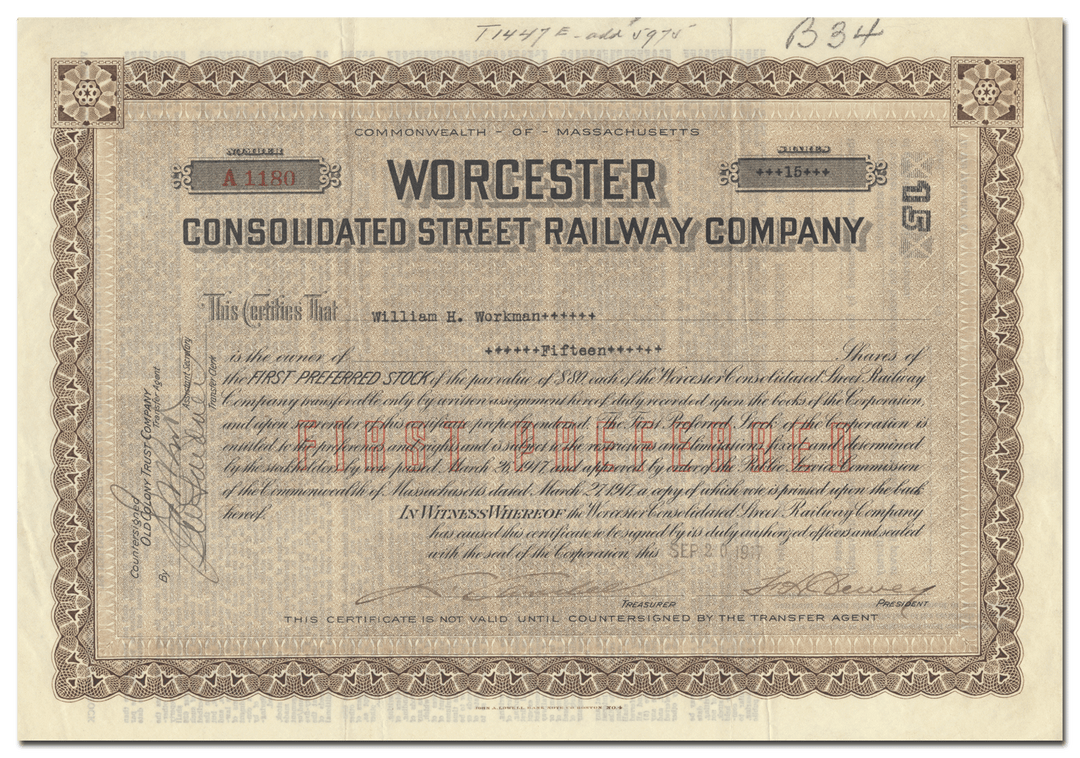
Worcester Consolidated Street Railway Company
- Guaranteed authentic document
- Orders over $75 ship FREE to U. S. addresses
Product Details
CompanyWorcester Consolidated Street Railway Company
Certificate Type
First Preferred Stock
Date Issued
September 20, 1917
Canceled
Yes
Printer
John A. Lowell Bank Note Company
Signatures
Hand signed
Approximate Size
11" (w) by 8" (h)
Images
Show the exact certificate you will receive
Guaranteed Authentic
Yes
Additional Details
NA
Reference
Historical Context
The Worcester Consolidated Street Railway was Worcester, Massachusetts largest. In 1906, it was purchased by Cornelius Vanderbilt’s New Haven railway and over the years combined with other surface railways in Springfield and Boston. Its network included urban lines that ran throughout the city, as well as a network that connected Worcester to other county cities and towns such as Fitchburg. The company built a steam-powered electrical plant in 1911 on Providence Road in Millbury to power its system.
Financial woes began to batter Worcester Consolidated by the mid 1920s. In the first nine months of 1926, the company lost $200,000. Most of the unprofitable lines were discontinued and county service was reduced to Webster, Southbridge, Fitchburg, Grafton and Woonsocket, R.I. In one case, the rails were even removed and sold to build a railroad in Egypt.
Complaints of slow service and poor equipment began to mount. In response, Worcester Consolidated contracted for 100 new cars in 1927 to be built by Worcester’s Osgood Bradley Car Co. and Springfield’s Wason Manufacturing Co., which had become the nation’s largest builder of railroad cars and locomotives. The new cars were state of the art and included high-tech features such as automatically opening rear doors.
News reports gleefully noted the new streetcars greatly increased efficiency and leap-frogged Worcester over the Boston Elevated Rail Co. Unfortunately, these changes seemed to have done little to stem the loss of ridership. By the late 1920s, Worcester Consolidated was put up for sale by the New Haven Railroad. There were no takers, however, and the company went into receivership in 1930 after it defaulted on $4.8 million in bonds.
In the end, economic realities undid the trolley system in Worcester. Over time, the company added bus routes to take over lines with high overhead and low ridership. In 1942, it announced it would end all remaining trolley service over the next three years. On Dec. 31, 1945, the final trolley left Leicester at 1:36 a.m. for downtown.
The driver, Leopaul Snyder, made the front page of the Telegram and is remembered as the last trolley driver in Worcester. Shortly after it ended service, the company sold many of its streetcars to Brazil for use in Rio de Janeiro.
Related Collections
Additional Information
Certificates carry no value on any of today's financial indexes and no transfer of ownership is implied. All items offered are collectible in nature only. So, you can frame them, but you can't cash them in!
All of our pieces are original - we do not sell reproductions. If you ever find out that one of our pieces is not authentic, you may return it for a full refund of the purchase price and any associated shipping charges.





